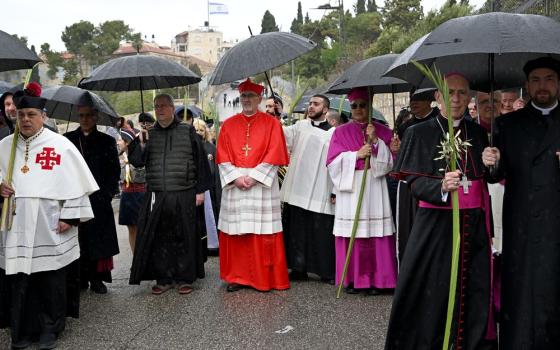Yesterday, I began my review of Cathleen Kaveny’s new book, Prophecy Without Contempt: Religious Discourse in the Public Square. There I looked at the first third of the book, which focuses on her analysis of four public intellectuals - Alasdair MacIntyre, John Rawls, Stephen Carter and John Murray Cuddihy - and their approach to the role of religious discourse in the public arena. She contended, correctly, that not all religious speech is deliberative, some of it is exhortatory and forensic, and that their theories failed to take account of this variety of religious speech in American history.
Kaveny then turns to that history and, for me, this is the most interesting part of the book, starting with New England Puritanism and “its dependence on the covenant theology that animated the religious and social vision of those early American migrants.” She shows how that covenant theology undergirded the development of the jeremiad, modeled after the prophetic language in the Hebrew Scriptures, in early American pulpits. Her argument is that “[d]espite its trenchant criticism of the community’s patterns of behavior, the jeremiad generally functioned as an instrument of social unity.” Kaveny argues that the jeremiad promoted social unity because it took the form of a legal indictment against violations of a widely accepted understanding of the people’s covenant obligations, first to God and secondly to each other. It was only after the jeremiad was used to address issues that were contentious, about which there was no widely accepted understanding of what was and was not acceptable behavior, that the jeremiad became a source of social division, not social unity. This is the heart of the book, and I do not want to say more than this, lest readers think they can get along by reading the review and not the text. Read the text: This history is fascinating.
This foray into colonial history, like the earlier chapters, contains little bonus observations, items not directly essential to the development of the thesis, but which show Kaveny’s capacity for insight. One such bonus point is found on page 185, where she writes:
For the Puritans, the breach of the covenant was their prevailing sins, which were more or less uncontroversial; the penalty was the loss of material prosperity. In our era, however, it seems that this structure is completely reversed. The uncontroversial covenantal obligation is to secure the nation’s economic and military well-being. Political parties that do so are rewarded with the opportunity to implement their own, contested vision of what counts as virtue and vice.
Read those sentences a couple of times through. Not only have I never heard this point made, but it is a point which, once made, seems so obvious and so significant, you slap your hand to your forehead. This phenomenon is one of the key steps in the secularization of U.S. culture, and it happened long before Barack Obama became President. (And, the step was only possible because of the assumptions of Protestantism, as Brad Gregory demonstrated in his book The Unintended Reformation, a thesis Kaveny confirms) This also explains why the culture wars have such staying power in our time: Elections are fought largely on economic and national security grounds, but each party’s base then insists on its own orthodoxy regarding the contentious social issues. Instead of a debate that ever resolves the contentions through reasoned compromise, we have a seesaw. This could be Kaveny’s next book.
Another bonus point comes a few pages later when Kaveny looks at the rhetoric surrounding the Salem witch trials. She notes: “The intricate logic of the covenantal system, based on repentance and forgiveness, could be twisted to diabolical ends in the name of resisting the Devil himself – and God did not step in to prevent it.” This resonates with what we see today among those whose hardened hearts lead them to twist everything Pope Francis says about mercy, using logic to continue their favorite pastime of judging others and hurling natural law theories or Church canons at other people like so many stones.
Kaveny’s text is littered with similar points which either flesh out her arguments or which make related points that are worth making. The missteps are few though one is important. Kaveny’s treatment of the Rev. Jonathan Mayhew misses the mark. She writes that the “force of his arguments is taken from a Lockean understanding of the nature of political authority rather than some form of covenant theology.” And, on the next page, she states, “Ostensibly, looking back a century to the Glorious Revolution against King Charles I, Mayhew’s sermon was eerily prescient of the arguments to be made by the Patriots a quarter century later.” Of course, the Glorious Revolution toppled Charles’ son James II, not Charles I, and this points to the key fact in understanding Mayhew: He was less indebted to Locke, who championed the Glorious Revolution and the court whigs who profited from it, than he was to the country whig ideology with roots in Milton and the Commonwealthmen, advocated later both by churchmen like Bishop Hoadley, and laymen like Thomas Gordon and John Trenchard, who published The Independent Whig and continued to wave the banner of the Commonwealth. These men, like Mayhew, were influenced a bit by Locke, but their real ideological roots were older and nastier. Mayhew would lead the fight against the Society for the Propagation of the Gospel, an evangelizing agency of the Church of England, and even Anglicans throughout the colonies were sufficiently influenced by the country whig doctrines that they opposed the establishment of a bishopric on this side of the Atlantic.
The rest of the book engages the differences between the rhetoric of the jeremiad, or prophetic indictment, and the language of moral deliberation which is the normal process by which most civic disputes are resolved, how the confusion of the two distorts the role of religion in public discourse, and how the misuse of either gives religion a bad name. Kaveny goes into detail about the proper uses of each style of moral intervention. Her take on various examples of the differing genres is smart and incisive. She concludes that the rhetoric of the jeremiad is a kind of moral chemotherapy, rooting out a fundamental threat to the body politic, designed not to win an argument but to call the entire society back to its first principles. Like regular chemotherapy, the jeremiad can harm the patient which is civil society, and so it should be used sparingly, and Kaveny brings in Just War theory which, mutatis mutandi, sets parameters for the use of the kind of rhetorical warfare the jeremiad represents. Her closing section on irony seems like a stretch and, unlike the previous sections of the book, the detour into the exegesis of the Book of Jonah taxes the reader’s attention.
Some books are a good read but are not important. Others are important but not a good read. Far too many books by academics indulge the jargon of the guild and produce volumes that are unreadable. This book is important, and good, and readable. I do not know if those religious figures who enter the public square will heed Kaveny’s counsel, but I do know that if they did, our civic discourse would be edified, and its incivilities restricted to times and issues which cry out for a prophetic stance.




